How Much a Frequent Flyer Point is Worth: Our Valuations

How much is a frequent flyer point worth?
Answering this question is a bit like calculating the length of a piece of string. There are lots of different ways to redeem your points, and the truth is, the value of a point really depends on how you use it.
Nonetheless, we’ve created a model that estimates an average value of frequent flyer points in Australia. It’s not 100% perfect, but it does provide a useful benchmark for valuing points and comparing airline loyalty programs. We intend to update these valuations periodically, so that you can see how point values change over time.
If you just want to see our valuations, please feel free to skip to the chart below! But for those who are interested, I first want to give a bit of an explanation about how we reached these figures.
Why it’s difficult to accurately value points
If you redeemed 10,930 Qantas points for a $50 WISH gift card, you’d be getting around 0.46 cents worth of value for each point. But if you used 10,900 points to upgrade a Sydney-Melbourne flight from Economy to Business Class – and the fare difference between the two cabins was $399 – then you would be getting around 3.66 cents of value out of each point. That’s quite a difference, and explains why it’s difficult to put an accurate value on frequent flyer points.
Even then, some AFF members would argue that this doesn’t account for the full picture. For example, they say you also need to consider the extra points and status credits you’d earn by buying the Business Class ticket outright. Others say that you can’t really value the Business Class ticket at the retail price if you wouldn’t have been prepared to pay that amount in the first place.
Of course, you also need to consider how easy it is to earn points. For example, although points in some overseas frequent flyer programs might be worth more than Qantas or Velocity Points, that’s largely theoretical if you don’t have a practical way to earn points in those overseas programs.

Why it’s worth valuing points
It can still be useful to calculate an average value of a frequent flyer point for four main reasons:
- It’s a good benchmark to use when deciding whether it’s worth incurring an additional cost to earn points. For example, you might have a credit card that earns 1.25 Qantas points per dollar, but incur a 1.5% payment surcharge with a supplier. Is it worth using that card to earn the points?
- It gives you a benchmark to consider when trying to work out whether a particular redemption is a good use of points in that program. For example, say you’re considering a Velocity Frequent Flyer redemption that’ll get you 1.2 cents per point. Is that above or below average? This will help you to work that out.
- It helps to compare the value of points across different programs. Of course, there are many other factors you should consider when deciding (for example) which airline program to transfer your bank reward points into – such as reward availability on the routes you actually want to fly. Nonetheless, it’s one of several factors that could aid your decision making.
- Publishing these figures helps to hold loyalty programs to account, by making it easier for consumers to see how their points stack up. In addition, by regularly updating these values, we can more easily see when frequent flyer programs have made sneaky devaluations.
Our calculation method
I worked with my colleague Wilson to come up with the AFF Point Valuation model. We both have economics degrees, and we thought it would make sense to use a similar approach to the way economists calculate inflation.
Just like when valuing points, there’s no single perfect way to calculate inflation because different products increase in price at different rates. So, economists compare price increases across a “basket” of different goods and take the average. This is also similar to how index funds work.
We’ve taken a very similar approach, but with an extra step:

Calculating the “trimmed mean” value
For each program, we first took the average value (calculated on a “cents per point” basis) of 16 redemptions. Our “basket” contains a cross-section of different types of redemptions that Australian travellers might typically make: from gift cards, to domestic Economy flights, to long-haul Business Class flights, to upgrades.
We deliberately chose redemptions which are generally available through most programs, which is why there aren’t any Premium Economy or First Class flights included in our basket.
We have accounted for the actual taxes & carrier charges on all flight redemptions. So, programs with high carrier charges have been “penalised” for that.
We then removed the highest and lowest-value redemption for each program, and took the average value of the remaining ones, giving us a “trimmed mean”. Doing this prevents one random outlier from skewing a program’s point valuation.
You can see a full list of the redemptions in our basket towards the bottom of this article.
Weightings
Finally, we’ve weighted the average redemption values up or down by up to 20% either way – based on a range of relevant qualitative factors that make points more or less valuable to Australian consumers. You can see a full explanation of the criteria used for these weightings at the bottom of this article!
Our logic with the weightings is that if a program has good reward availability and its points are easy to use, Australians are more likely to be able to access some of the higher value rewards. In that case, the points are intrinsically worth a bit more.
Conversely, if points are hard to use, the best value redemptions are rarely available and the points expire easily, this decreases the average value a typical Australian is likely to receive from their points.
Other things to note
Keep in mind that our AFF Points Valuation model is not a comparison of airlines or frequent flyer programs as a complete package. We’re only giving an average value of the points in each loyalty program, from an Australian perspective. Note also that our valuations are in Australian currency (AUD) and rounded to one decimal place.
Our model does not account for other things like status benefits, nor extra things like the ability for Points Club members to earn status credits on Qantas Classic Flight Reward tickets.
So, while no Point Valuation model is perfect, this at least gives you a useful starting point!
Our Frequent Flyer Point Valuations
Without further ado, here are our Point Valuations for the 12 frequent flyer programs that we compared, as of July 2025. Click on the chart below to view a larger version:
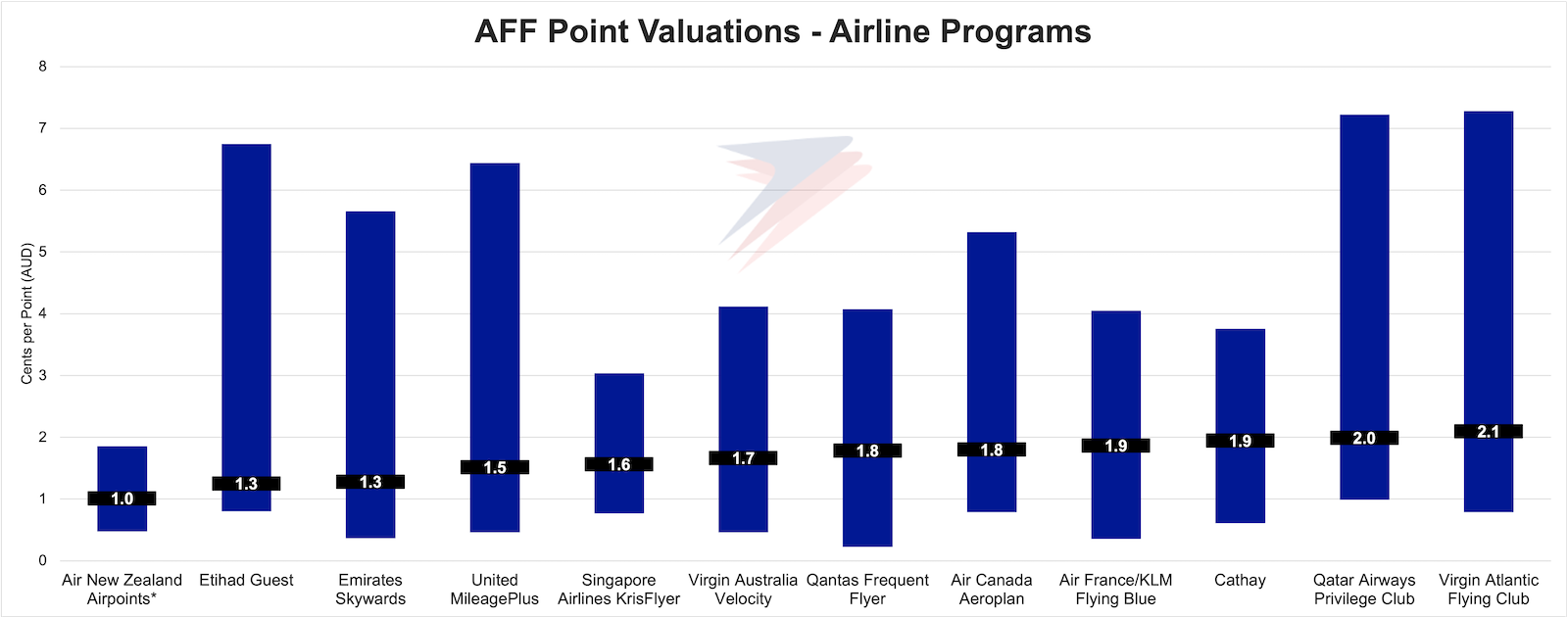
For each program, the blue bar shows the full range of values for the redemptions in our “basket”. The value in the black box is the weighted average value.
Please note that Air New Zealand Airpoints uses a completely different system, whereby 1 Airpoints Dollar is equivalent to one actual dollar. Because of this, most credit card reward points convert to Airpoints at a rate of 200:1 instead of the usual 2:1. To allow for fair comparisons, we’ve divided the average value of an Airpoint by 100 in the chart above. However, our analysis shows that the average value of 1 Airpoints Dollar is indeed around $1.
Observations
Here are a few things that stood out to us in our research…
- Of the 12 programs compared, Virgin Atlantic Flying Club points, Qatar Airways Privilege Club Avios and Cathay Asia Miles have the highest average redemption values for Australians
- Air New Zealand, Etihad and Emirates offer the lowest average value for the redemptions that we looked at
- Most international programs offer significantly better value on gift card redemptions compared to Qantas and Velocity
- The value of a round-trip Business Class redemption to Europe with Qantas Frequent Flyer was “only” 2.12 cents per point. That’s still decent, but we expected it to be higher. The high number of points required and reasonably high carrier charges reduced the redemption value somewhat.
Why Virgin Atlantic Flying Club is a valuable program
Virgin Atlantic Flying Club offers relatively good value redemptions, with lower points requirements than other programs for similar flights. In addition, Virgin Atlantic is part of SkyTeam, and there is very good reward flight availability on key routes. This includes from Australia to Asia with partner airlines such as Garuda Indonesia and Vietnam Airlines.
With Virgin Atlantic Flying Club, you can also book trans-Tasman flights on Air New Zealand as well as Economy Class flights on Virgin Australia.
Although our analysis found that Virgin Atlantic Flying Club had the most valuable points of the programs compared, note that this is a UK-based program. It often awards points for every British pound (GBP) spent, rather than every Australian dollar (AUD) spent… and 1 GBP is worth roughly 2 AUD. So, while the points are more valuable on paper, you might not necessarily be able to earn them at the same rate as with other programs.
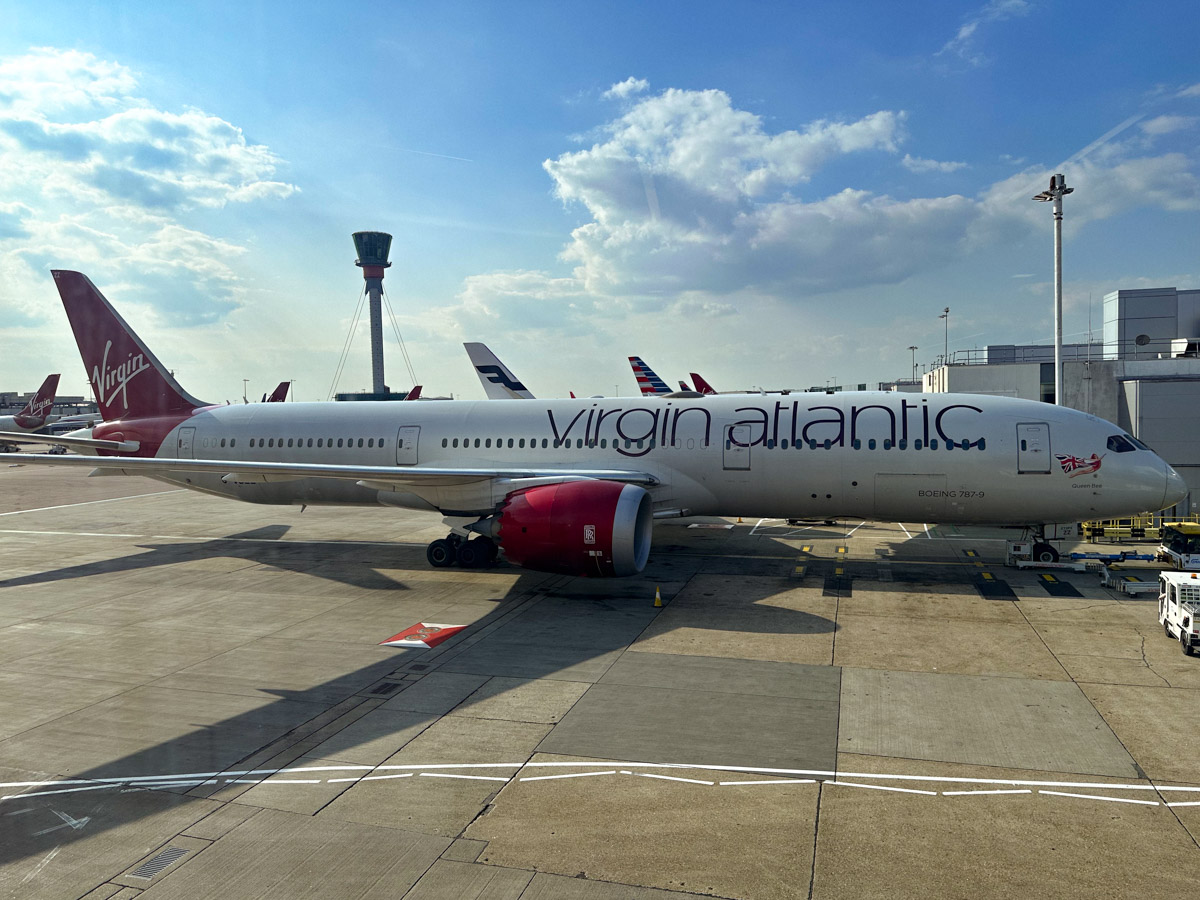
Meanwhile, Qatar Airways Privilege Club is a particularly valuable program for redemptions on Qatar Airways, Oneworld airlines and other unique partner airlines.
Cathay is also a great value program for redemptions on Oneworld airlines, and offers very good premium cabin reward availability on Cathay Pacific flights – including between Australia and Hong Kong.
Qantas vs Velocity
Our analysis puts Qantas Frequent Flyer and Virgin Australia Velocity in around the middle of the pack. However, it’s worth considering that it’s a lot easier to earn large amounts of Qantas and Velocity Points in Australia – especially through Qantas points-earning credit cards and Velocity credit cards. You can also easily earn Qantas and Velocity Points at Australian supermarkets, petrol stations and when shopping online.
Currently, the AFF Point Valuations show that Qantas Frequent Flyer redemptions are – on average – more valuable than Velocity Frequent Flyer redemptions. However, there are two key caveats:
- Qantas Frequent Flyer will increase its Classic Flight Reward and upgrade pricing on 5 August 2025 by 10-20%, which will bring down the value of a Qantas Point in our next update
- On average, Qantas has higher airfares than Virgin Australia. This does mean that Qantas Points appear to be worth more on some routes, even though Velocity is actually charging fewer points and/or lower taxes & charges for an equivalent redemption on that route. (At the same time, one could argue that Qantas’ flight is worth more because you get access to better lounges, or more inclusions on board…)
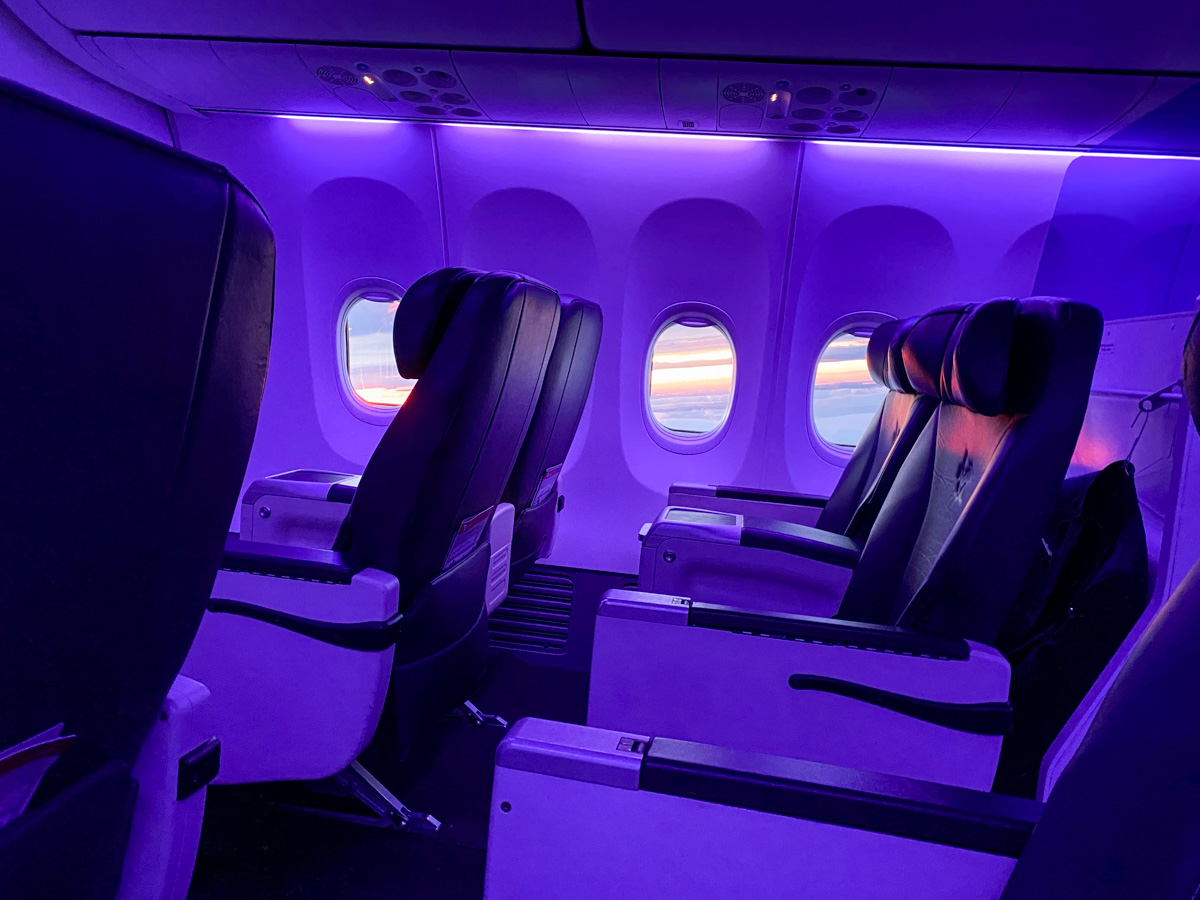
What’s in our “basket” of redemptions?
For those who are interested, here’s a bit more information about how we got to our final figures.
Firstly, we based our average Point Valuations on the following 16 redemptions:
- Gift card
- Hotel booking
- Points+Pay booking (i.e. using points as cash to offset the cost of a commercial airfare)
- Economy reward flight from Brisbane (BNE) to Mackay (MKY)
- Business reward flight from Brisbane (BNE) to Sydney (SYD)
- Economy reward flight from Perth (PER) to Melbourne (MEL)
- Economy reward flight from Sydney (SYD) to Queenstown (ZQN)
- Business reward flight from Sydney (SYD) to Queenstown (ZQN)
- Economy reward flight from Melbourne (MEL) to Bali (DPS)
- Economy reward flight from New York (JFK) to London (LHR)
- Business reward flight from Sydney (SYD) to Singapore (SIN)
- Business reward flight from Sydney (SYD) to Tokyo (HND)
- Economy reward flight from Sydney (SYD) to Los Angeles (LAX)
- Economy reward flight from Perth (PER) to London (LHR)
- Business reward flight from Sydney (SYD) to Frankfurt (FRA)
- A long-haul upgrade on a popular long-haul route flown by that airline from flexible Economy or (if available) Premium Economy to Business Class
We looked at the cost of one-way tickets on the domestic routes that we included, and round-trip tickets on the international routes.
On average, across all the programs we looked at, the least valuable redemptions were for gift cards. The most valuable redemptions were Business Class flights between Australia and Asia.
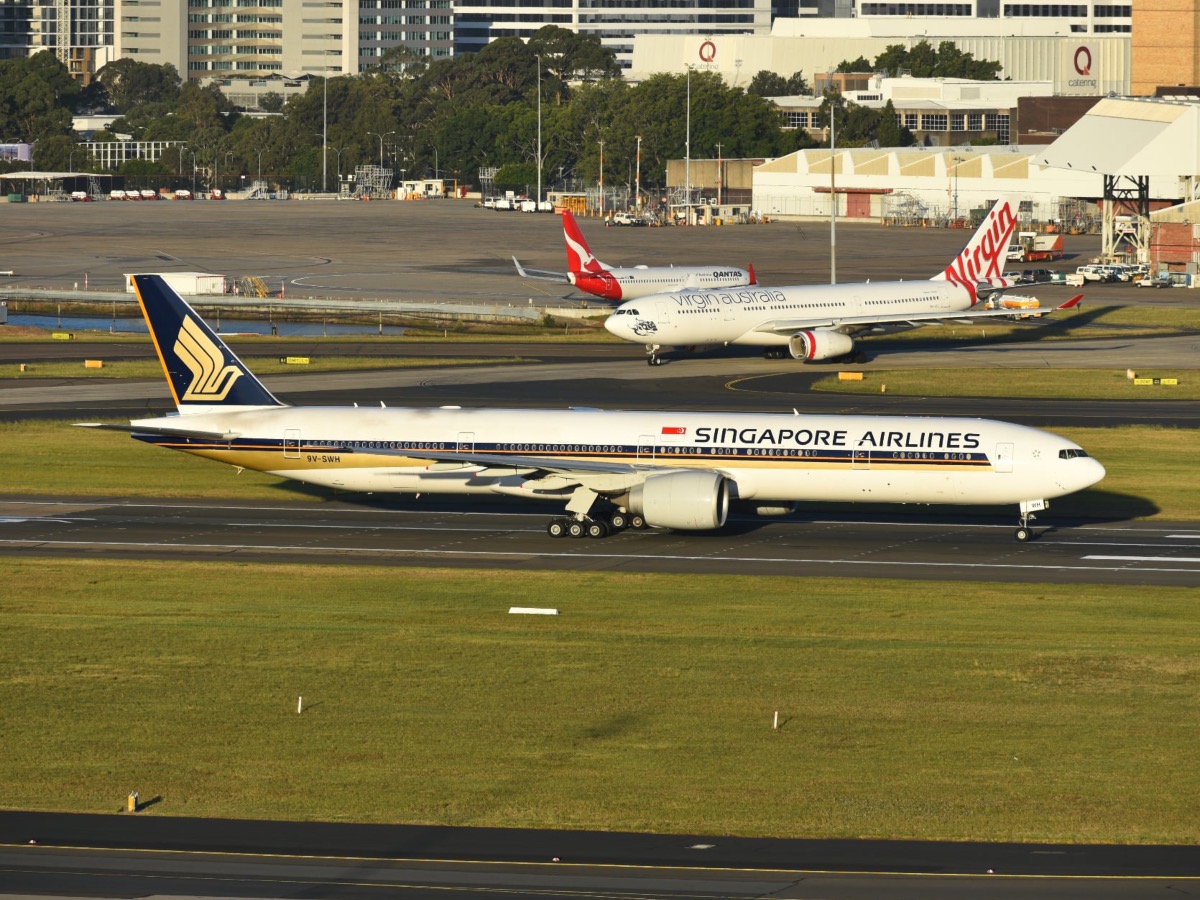
Note that we weren’t able to find a value for a few specific redemptions with certain programs, for the following reasons:
- Air New Zealand Airpoints doesn’t offer hotel redemptions
- Virgin Atlantic Flying Club doesn’t let you redeem points for domestic Business Class redemptions on Virgin Australia, but you can book Economy
- There’s no longer any way to redeem Etihad Guest miles on domestic Australian routes
- The only way to use Aeroplan points to upgrade is to bid using points, giving you a value of around 1 Canadian cent per point
In some cases, where a route wasn’t available to book through a particular program (e.g. because no partner airline flies that route), we’ve used a comparable route instead. For example, Sydney-Auckland instead of Sydney-Queenstown.
What goes into our weightings
Finally, here’s a deeper explanation of the weightings we applied to our valuations of frequent flyer points and credit card reward points.
These weightings increase or decrease a program’s point valuation by up to 20% (if very good in all areas) or down by up to -20% (if very poor in all areas). There is no change to the value if the grade is “average”.
Frequent flyer program weighting criteria
The weightings for our frequent flyer point valuations are based on the following five criteria, which each individually have an impact between 15-35% on the final weighting:
| Rating | Network & reward flight availability (35%) | Redemption experience (20%) | Consistent redemption pricing (15%) | Points expiration policy (15%) | Ease of earning points in Australia (15%) |
|---|---|---|---|---|---|
| Very good | Great network of flights bookable as awards and great award availability in Economy & premium cabins | Can book most/all awards online, good call centre, limited booking issues | Consistent award chart pricing + gives notice before making changes | Points never expire | Lots of ways to earn points from everyday activities and credit cards |
| Good | Large network of flights bookable as awards and you can often find seats in multiple cabins | Can book many awards online, call centre is generally fine | Has award charts and is reasonable with changes | Long expiration date (more than 2 years), activity based | Lots of ways to earn points from credit cards, moderate range of options from other activities |
| Average | Large network with moderate award availability, or a moderate network with good availability | Can book many awards online but call centre has issues, or many bookings require a call but call centre is generally good | Gives notice before making major changes | Expiration period of 1.5-2 years, activity based | 3+ credit card transfer partners and some options from other activities |
| Poor | Difficult to find award seats to many destinations, but there are some awards | Many awards cannot be booked online and the call centre is OK, but not great | Does not have award charts (full dynamic pricing) or T&Cs allow the program to make changes without notice | Activity-based expiration under 1.5 years | Can transfer from 2+ credit card programs and buy points at a reasonable rate, but limited other options |
| Very poor | Very little award availability and partner airlines don’t make up for this | Most bookings require a phone call, the call centre is poor and there are often booking issues | Does not have award charts (full dynamic pricing) and a history of changing prices without notice | Time stamping and/or specific activity types required to prevent expiry | Difficult to earn points in Australia |
This is how each of the ranked airline programs fared in each category:
| Program | Network & reward flight availability | Redemption experience | Consistent redemption pricing | Points expiration policy | Ease of earning points in Australia |
|---|---|---|---|---|---|
| Qantas Frequent Flyer | Average | Average | Very good | Average | Very good |
| Virgin Australia Velocity | Average | Average | Very good | Average | Very good |
| Cathay | Good | Poor | Poor | Average | Good |
| Qatar Airways Privilege Club | Good | Poor | Very poor | Good | Average |
| Singapore Airlines KrisFlyer | Very good | Average | Very good | Very poor | Good |
| Air New Zealand Airpoints | Average | Average | Poor | Very poor | Average |
| Etihad Guest | Very poor | Poor | Very poor | Very poor | Average |
| Emirates Skywards | Poor | Poor | Very poor | Very poor | Poor |
| Virgin Atlantic Flying Club | Good | Average | Poor | Very good | Poor |
| Air Canada Aeroplan | Very good | Very good | Very good | Average | Poor |
| Air France/KLM Flying Blue | Good | Average | Very poor | Very poor | Poor |
| United MileagePlus | Average | Good | Very poor | Very good | Poor |

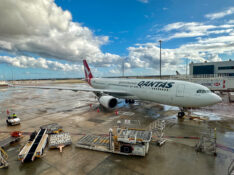

Community Comments
Loading new replies...
Join the full discussion at the Australian Frequent Flyer →